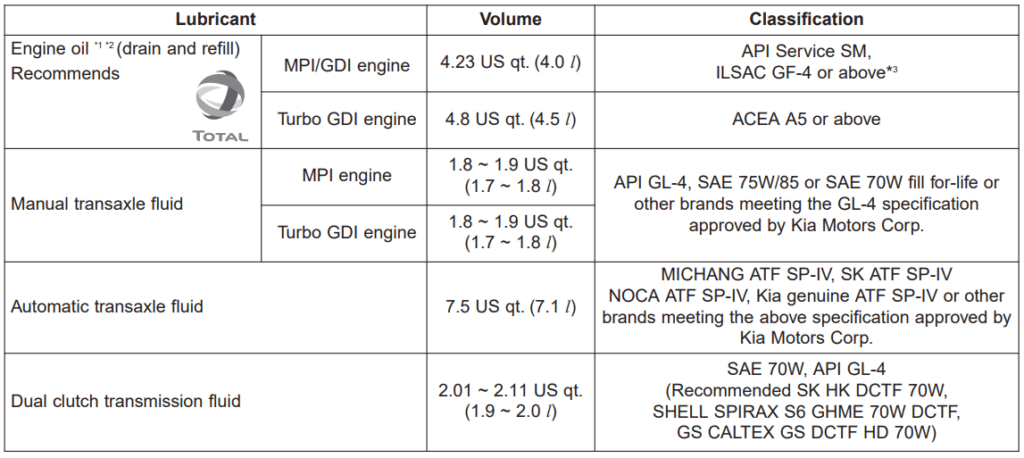The Kia Forte, a beloved compact car, has been gracing our roads since 2010. Throughout its different generations, the Forte has boasted a variety of transmission systems, each designed to optimize performance and enhance the driving experience.
Whether you’re navigating the city streets or enjoying a long highway drive, the transmission plays a pivotal role in how your Forte responds, accelerates, and transitions between speeds.
But, much like the heart needs blood to function correctly, your Forte’s transmission requires the right fluid to operate smoothly. Regular maintenance, especially concerning transmission fluid, ensures that this intricate system remains in peak condition, reducing wear and prolonging the life of the vehicle.
It’s not just about changing the fluid; it’s about understanding its significance and ensuring you’re using the correct type for your Forte’s specific generation.

What is Transmission Fluid?
At its core, transmission fluid is a specially formulated liquid that lubricates, cools, and cleans the moving parts of your vehicle’s transmission. It’s not just about reducing friction; this fluid plays a multifaceted role. It helps in transferring power from the engine to the transmission, allowing you to experience seamless gear shifts and consistent acceleration.
Why is the Correct Fluid Type So Important?
Choosing the right transmission fluid for your Kia Forte is paramount. Each generation of the Forte might have slight variations in its transmission design, and the wrong fluid type can result in subpar performance, increased wear, or even damage. Using the correct fluid ensures:
- Optimal Lubrication: Reducing wear and tear on gears and moving parts.
- Proper Cooling: Preventing overheating and potential damage.
- Efficient Power Transfer: Make sure that your Forte responds promptly when you hit the accelerator.
In essence, the right transmission fluid is not just about maintaining; it’s about optimizing. By understanding its role and the importance of using the correct type, you’re not just taking care of your Kia Forte – you’re ensuring that every drive is as smooth and enjoyable as it’s meant to be.
Kia Forte Transmission Fluid Capacity And Transmission Fluid Type
The Kia Forte, throughout its various generations, has seen innovations in design, technology, and performance. But one constant is the need for specific transmission fluids to ensure optimal functioning.
Maintaining the appropriate level of transmission fluid is crucial for the optimal functioning of your Kia Forte’s transmission system. Overfilling or underfilling can both lead to issues, making it imperative to know the right capacity for each generation.
2010-2013 Kia Forte Transmission Fluid Capacity And Transmission Fluid Type
The 2010-2013 Kia Forte is well-regarded for its reliability, and part of that reputation comes from its well-engineered transmission system. Proper maintenance, including using the right transmission fluid type in the correct amount, is crucial for optimal performance and longevity. Here are the specifics for the 2010-2013 Kia Forte models:
| Gearbox | Fluid capacity | Fluid type |
|---|---|---|
| 4-speed A4CF2 automatic | Total fill: 7 quarts (6.6 liters) | ATF SP-IV |
| 5-speed A5CF2 automatic | Total fill: 8 quarts (7.6 liters) | ATF SP-IV |
| 6-speed A6MF1 automatic | Total fill: 7.5 quarts (7.1 liters) | ATF SP-IV |
| 5-speed manual | 4 pints (2 quarts; 1.9 liters) | API GL-4 75W-85 |
| 6-speed manual | 4 pints (2 quarts; 1.9 liters) | API GL-4 75W-90 |
Remember, always refer to your vehicle’s owner manual for any specific recommendations or specifications.
2014-2018 Kia Forte Transmission Fluid Capacity And Transmission Fluid Type
The Kia Forte from 2014 to 2018 continues the legacy of its predecessors with efficient and reliable transmission systems. For this generation, both the manual and automatic transmissions maintain the robustness associated with Kia vehicles. Proper maintenance remains paramount, and knowing the correct transmission fluid type and capacity is vital. Here are the details for the 2014-2018 Kia Forte models:
| Gearbox | Fluid capacity | Fluid type |
|---|---|---|
| 6-speed A6MF1 automatic | Total fill: 7.5 quarts (7.1 liters) | ATF SP-IV |
| 6-speed A6MF1-2 automatic | Total fill: 7.5 quarts (7.1 liters) | ATF SP-IV |
| 6-speed manual | 3.8 pints (1.9 quarts; 1.8 liters) | API GL-4 75W-90 |

Maintaining the right transmission fluid levels and ensuring the use of the specified fluid type is essential for the longevity and smooth operation of the transmission system.
2019-Now Kia Forte Transmission Fluid Capacity And Transmission Fluid Type
The latest generation of the Kia Forte, starting from 2019, brought with it advancements in transmission technology. This evolution ensures smoother drives, enhanced efficiency, and increased longevity. As always, proper transmission maintenance is critical for optimal vehicle performance. Here are the specifics for the 2019 onwards Kia Forte models:
| Gearbox | Fluid capacity | Fluid type |
|---|---|---|
| 7-speed automatic | Total fill: 7.5 quarts (7.1 liters) | ATF SP-IV |
| Intelligent Variable Transmission (IVT) | Total fill: 7.1 quarts (6.7 liters) | IVTF SP-CVT1 |
| 6-speed manual | 1.8 quarts (1.7 liters) | API GL-4 70W |
Guidance on Checking Transmission Fluid Levels
- Warm Up the Vehicle: Start the vehicle and let it run for a few minutes to warm up the transmission fluid, ensuring it expands to its operational level.
- Position on a Flat Surface: Ensure the vehicle is on a level surface to get an accurate reading.
- Shift Through Gears: If your vehicle has an automatic transmission, shift through each gear and then return to ‘Park.’ This circulates the fluid through the system.
- Locate the Dipstick: Open the hood and find the transmission fluid dipstick, usually marked with a red or brightly colored handle.
- Check the Fluid: Pull out the dipstick, wipe it clean, reinsert it fully, and then pull it out again to check the level. The fluid should be between the “full” and “add” marks. Also, note the fluid’s color. Healthy transmission fluid should be reddish and not have a burnt smell.
- Add Fluid if Necessary: If the fluid level is below the “add” mark, you’ll need to add the recommended transmission fluid. Use a funnel to avoid spills and add the fluid in small amounts, checking the level each time to prevent overfilling.
- Regular Check-ups: It’s a good practice to check your transmission fluid level monthly, especially if you notice any transmission performance issues.
Regular monitoring and maintenance of your Kia Forte’s transmission fluid ensure that your vehicle runs smoothly, and efficiently, and remains in optimal condition for years to come.
The Pitfalls of Utilizing the Wrong Fluid Type
Using an incorrect transmission fluid type for your Kia Forte can have several undesired consequences:
- Performance Decline: The wrong fluid might not provide the necessary lubrication, leading to rough shifts or a sluggish response.
- Increased Wear: Without proper lubrication, the transmission components can wear out faster, potentially leading to expensive repairs.
- Overheating: The right fluid cools the transmission efficiently. Using an incorrect fluid type might lead to transmission overheating, which can be detrimental in the long run.
- Contamination: Mixing different types of fluids can cause contamination, leading to clogged filters and reduced fluid effectiveness.
- Potential Damage: In the worst-case scenario, using the wrong fluid can lead to significant transmission damage, requiring extensive repairs or replacements.
Changing Transmission Fluid for Kia Forte
Transmission fluid plays a pivotal role in ensuring the smooth functioning of your Kia Forte’s transmission system. Over time, this fluid can degrade or become contaminated, affecting its effectiveness. Regularly changing the transmission fluid can prolong the life of your vehicle and optimize its performance.
Signs Indicating a Need to Change Transmission Fluid
- Color Change: Fresh transmission fluid is typically a transparent reddish hue. A dark brown or black color can indicate aged fluid or contaminants.
- Burnt Smell: If the fluid emits a burnt odor, it’s an urgent sign that it should be replaced.
- Gears Slipping: If you experience unexplained shifts in gears or difficulty in shifting, the fluid may be the culprit.
- Delayed or Jumpy Shifting: Hesitations or hard shifts when changing gears can point to degraded fluid.
- Transmission Noises: If you hear grinding or whining noises when your vehicle is in neutral, it might be due to low or degraded fluid.
- Transmission Warning Light: Modern vehicles come equipped with sensors that can detect issues with the transmission fluid.
Methodical Steps to Replace the Transmission Fluid in a Kia Forte
- Vehicle Preparation: Start by warming up your vehicle. This makes the fluid less viscous and easier to drain. Once warmed, switch off the vehicle and ensure it’s on a level surface.
- Safety First: Ensure you’re wearing protective gloves and eyewear. The fluid can be hot and can cause burns.
- Drain Old Fluid: Position a drain pan beneath the transmission fluid pan. Loosen and remove the drain plug to allow the old fluid to flow out.
- Remove the Transmission Pan (if applicable): For a thorough change, some mechanics recommend removing the transmission pan to clean it and replace the filter. This isn’t always necessary for every change, but it can ensure contaminants are removed. Replace the gasket if it’s worn.
- Replace the Filter: After cleaning the pan, replace the transmission filter. It’s an essential step as the filter captures and holds contaminants, preventing them from circulating within the transmission.
- Refill with New Fluid: Using a funnel, pour in the new transmission fluid through the dipstick tube or fill hole. Be sure to use the recommended fluid type for your Kia Forte generation. Don’t overfill.
- Start and Check: Once filled, start your vehicle and, with your foot on the brake, shift through all the gears. This helps circulate the new fluid. Check for leaks and ensure the fluid level is correct.
- Monitor: After the change, monitor your transmission’s performance. Ensure shifts are smooth and there are no unusual noises.
Changing your Kia Forte’s transmission fluid at regular intervals, or when you notice the aforementioned signs, can go a long way in maintaining its performance and extending the vehicle’s lifespan. As always, when in doubt, consult with a professional mechanic or your Kia dealer.
Benefits of Regular Maintenance
The maintenance of a car, particularly its transmission system, is akin to the regular checkups we have with our doctors. It keeps our vehicle in prime condition, ensuring it performs optimally and safely. Here’s why regular checks and changes of transmission fluid are critical:
- Prolonged Vehicle Lifespan: Just as regular exercise keeps the heart healthy, consistent transmission fluid checks ensure the heart of your vehicle – its transmission system – remains in optimal condition, significantly increasing its lifespan.
- Cost Savings: While regular checks might seem like an unnecessary expense, they prevent more significant issues that can be far costlier in the long run.
- Optimized Fuel Efficiency: Clean and efficient transmission systems mean smoother gear shifts and reduced engine strain, leading to improved fuel consumption rates.
- Enhanced Performance: Your vehicle runs smoother, faster, and more efficiently with regular transmission fluid changes. It ensures you get the best out of your Kia Forte.
- Safety: A well-maintained transmission system reduces the risk of unexpected breakdowns, ensuring your safety on the road.
FAQs
Q: How often should I check my Kia Forte’s transmission fluid?
A: Typically, it’s recommended to check the transmission fluid levels every 30,000 to 60,000 miles, but replacement is needed for every 100,000-120,00 miles. However, always refer to the vehicle’s owner’s manual or consult with your Kia dealer for specific recommendations.
Q: Can I change the transmission fluid by myself?
A: Yes, with the right tools and knowledge, you can. However, if you’re unsure, it’s best to leave it to professionals to avoid any potential damage.
Q: Why has my transmission fluid turned dark?
A: Over time, due to heat and contaminants, transmission fluid can oxidize, resulting in a darker color. It’s a sign that it’s time for a change.
Q: Is it harmful to overfill my transmission with fluid?
A: Yes, overfilling can lead to erratic shifting, oil starvation, or transmission damage. Always ensure the fluid level is within the recommended range.
Q: Can I mix different brands of transmission fluid?
A: It’s essential to use the fluid type recommended for your Kia Forte. Mixing different brands or types can lead to reduced performance or even damage. If in doubt, always consult with a mechanic or your Kia dealer.
Regular maintenance, particularly of the transmission fluid, is not just a recommendation but a necessity. It ensures that your Kia Forte continues to provide reliable and efficient performance, ensuring peace of mind every time you hit the road.
















